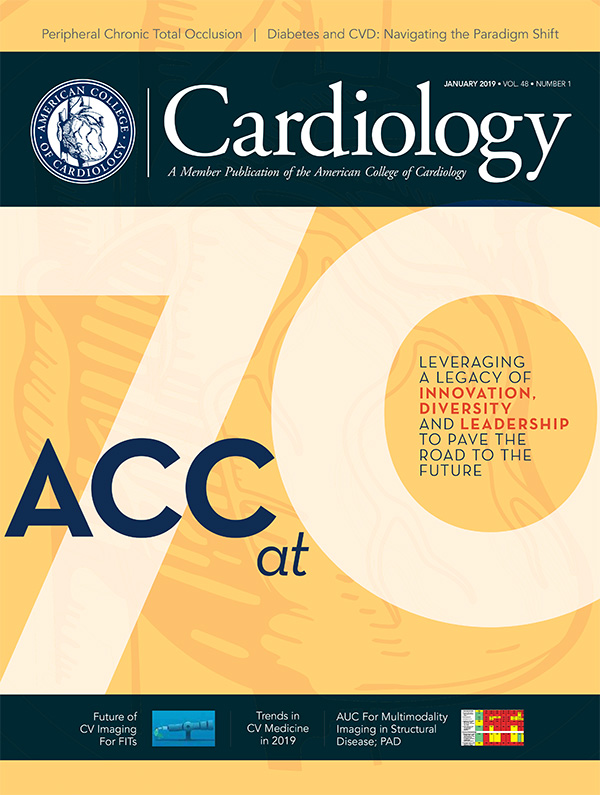New in Clinical Documents | Multimodality Imaging in Assessing Cardiac Structure and Function in Structural Heart Disease
New appropriate use criteria (AUC) released by the ACC and several other partnering societies focus on the use of multimodality imaging in the diagnosis and management of cardiac structure and function in nonvalvular, or structural, heart disease (SHD).
This document is the companion to AUC released in 2017 addressing the evaluation and use of multimodality imaging in the diagnosis and management of valvular heart disease. Both documents, taken together, are intended to provide a comprehensive resource for multimodality imaging.
The criteria are divided into three primary sections: 1) initial evaluation of cardiac structure and function; 2) evaluation in patients with prior testing; and 3) evaluation in patients undergoing transcatheter intervention for SHD. A broad spectrum of clinical scenarios have been added, with the goal of helping to determine "the range of modalities that may or may not be reasonable for specific indications rather than the determination of a single best test for each indication or a rank order." An independent rating panel scored the scenarios, assessing whether the use of an imaging test for each indication fell into one of the following categories: Appropriate, May Be Appropriate or Rarely Appropriate.
In terms of initial evaluation, the rating group considered a variety of clinical scenarios for evaluating both asymptomatic and symptomatic patients. For asymptomatic patients, transthoracic echo (TTE) was rated Appropriate for evaluation of patient with a known disease state that could be associated with SHD; evaluation for SHD in first-degree relatives of a patient with inherited cardiomyopathy; initial evaluation prior to exposure to potentially cardiotoxic medications; and pre-participation assessment of asymptomatic athletes with family history of heart disease, an abnormal exam, and/or an abnormal ECG.
However, it was rated Rarely Appropriate for pre-participation assessment of athletes with no symptoms or family history and normal examination. Strain rate imaging by speckle tracking, computed tomography (CT) imaging and computed magnetic resonance (CMR) imaging were rated May Be Appropriate in several scenarios, with CT and CMR identified as Appropriate for the evaluation of the thoracic aorta.
Patients with signs or symptoms of heart disease were divided into categories of arrhythmias or conduction disorders; palpitations/presyncope/syncope; hypotension or hemodynamic instability; hypertensive heart disease; acute coronary syndrome; respiratory failure/exertional shortness of breath; heart failure/cardiomyopathy; and pulmonary hypertension.
The authors note that "the modality chosen depends upon the disease state for which the clinician wishes to evaluate." However, TTE was the modality recognized as Appropriate in most scenarios. Stress echo was Rarely Appropriate in nearly all cases, except for evaluation of exertional shortness of breath/dyspnea or hypoxemia of uncertain etiology and initial evaluation of known or suspected heart failure based on symptoms, signs or abnormal test results.
F-18 fluorodeoxyglucose-positron emission tomography (FDG PET) and technetium 99m pyrophosphate injection (Tc-99m PYP) received a May Be Appropriate rating for evaluation of cardiac sarcoid and amyloid, respectively, but otherwise were considered Rarely Appropriate.
When evaluating patients with prior testing, the new AUC are broken down into three separate tables looking at clarifying an initial diagnosis, assessing for clinical stability when a diagnosis has been established and sequential or follow-up testing in patients with new or worsening symptoms.
Of note, the rating group found all modalities to be Rarely Appropriate "when used for repeat imaging in less than one year in patients at risk of heart failure without structural heart disease, with known hypertension without a change in their clinical status, or with systolic or diastolic heart failure without a change in clinical status."
However, in patients previously or currently undergoing therapy with potentially cardiotoxic agents, repeat TTE, strain rate imaging by speckle and radionuclide ventriculography in less than one year was considered Appropriate. CMR was rated May Be Appropriate in this scenario as well.
Additionally, CMR and CT were considered May Be Appropriate in less than one year when reevaluating the size and morphology of the aortic sinuses and ascending aorta in patients with a bicuspid valve with an initial aortic dilatation >4.5 cm, family history of dissection or rapid rate of change in aortic diameter.
A variety of modalities "showed utility," according to the writing group, in terms of sequential or follow-up testing in symptomatic patients. They also noted that "although [TTE] was generally ranked Appropriate for most of the scenarios, there was a significant role for transesophageal echo in specific indications such as evaluation of the thoracic aorta and resolution of intracardiac thrombus."
To help guide in the evaluation of patients undergoing transcatheter interventions for SHD, three tables included in the document focus on imaging for evaluation of transient ischemic attacks or ischemic stroke; evaluation for closure of a patent foramen ovale or atrial septal defect; and preprodedural, intraprocedural and postpocedural assessment of patients undergoing left atrial appendage occlusion device placement.
The ACC/AATS/AHA/ASE/ASNC/HRS/SCAI/SCCT/SCMR/STS 2019 Appropriate Use Criteria for Multimodality Imaging in the Assessment of Cardiac Structure and Function in Nonvalvular Heart Disease was published in the Journal of the American College of Cardiology. Click here for the full document.
Keywords: ACC Publications, Cardiology Magazine, Fluorodeoxyglucose F18, Cardiotoxins, Aorta, Thoracic, Heart Failure, Diastolic, Mitral Valve, Acute Coronary Syndrome, Atrial Appendage, Brain Ischemia, Dilatation, Follow-Up Studies, Area Under Curve, Technetium, Stroke, Athletes, Foramen Ovale, Patent, Ischemic Attack, Transient, Goals, Tomography, X-Ray Computed, Multimodal Imaging, Syncope, Radionuclide Ventriculography, Arrhythmias, Cardiac, Diphosphates, Heart Valve Diseases, Cardiomyopathies, Hypotension, Hypertension, Positron-Emission Tomography, Dyspnea, Cell Hypoxia, Respiratory Insufficiency, Magnetic Resonance Spectroscopy, Hypertension, Pulmonary, Hemodynamics, Thrombosis, Electrocardiography
< Back to Listings

